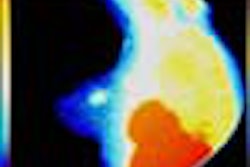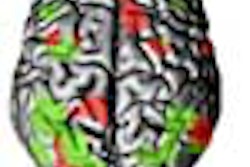UCLA researchers say they have developed a fluorine-based PET radiotracer that detects the neural plaques and tangles that signify the onset of Alzheimer’s disease.
The technique, which is still in the investigational stage and has been administered to only about 30 patients, enables radiologists for the first time to directly label these anatomic markers in living patients. Because of this, the UCLA team believes the radioactive molecule, DDNP (2-(1,1-dicyanopropenyl-2)-6-dimethylaminonaphthalene), could advance imaging’s role in both the early detection of Alzheimer’s and in the development of several drugs.
Although PET (using the FDG radiotracer) and functional MRI have been used for several years to image the metabolic and brain activation anomalies that indicate Alzheimer’s, these subtle changes only suggest the disease rather than conclusively indicate it. Current PET and MRI techniques are therefore useful for ruling out other diseases and augmenting clinical evaluations, but they can’t diagnose Alzheimer's.
Amyloid-rich plaques and neurofibrillary tangles, on the other hand, are believed to be the most definitive marker of Alzheimer’s, particularly in elderly people with memory loss. Researchers suspect that their proliferation damages nerve cells and inflames brain tissue, and that these processes combine to cause the symptoms of Alzheimer’s. Find the tiny lesions, the theory goes, and you will likely find the disease.
Unfortunately, these red flags are currently only identifiable at autopsy or with not-so-sensitive monoclonal antibodies and stains that have trouble passing through the blood-brain barrier, a filtration system that protects the brain from potentially harmful substances carried in the bloodstream. That’s where DDNP comes in: it easily passes through tissues and membranes, including the highly selective and resistant blood-brain barrier, and attaches itself to plaques and tangles, which are then detected on a PET scan.
"We have developed a family of tracers -- the first in the world -- that home in on plaques and tangles," said Jorge Barrio, Ph.D., professor of molecular and medical pharmacology at UCLA.
The importance of developing a highly accurate, noninvasive diagnostic test for Alzheimer’s is underscored by the fact that current tests only have a 55% accuracy rate compared to autopsy-obtained diagnoses, Barrio said.
"And this is when patients are well advanced with the disease. Imagine how low the accuracy rate is early in the pathology," he said.
There are also a number of plaque-inhibiting drugs in development that could slow progression of the disease. Barrio believes the DDNP test could identify patients who have preclinical Alzheimer’s, and are therefore ideal patients to include in clinical trials testing the efficacy of these drugs. Ultimately, the DDNP test could be used to screen at-risk but asymptomatic patients, and help channel people with the disease into drug treatment before irreversible dementia sets in, he said.
Barrio, along with Dr. Gary Small of UCLA’s Neuropsychiatric Institute, discovered DDNP’s ability to label plaques and tangles about four years ago while studying the molecule’s fluorescent properties. After testing the molecule in animals, they labeled it with positron emitters and began conducting the first PET-based human research.
In one of their first studies, presented at the 1999 American College of Neuropsychopharmacology (ACNP) meeting, the team imaged seven Alzheimer’s patients and three control subjects with PET after administering an intravenous injection of DDNP. They then compared these images with those rendered from more conventional imaging techniques, FDG-PET and MRI.
They found that the new tracer matched MRI’s ability to assess brain atrophy, and also correlated well with FDG’s ability to measure glucose uptake. DDNP also produced excellent visualization of plaques and tangles, according to the researchers.
The UCLA team is currently testing the sensitivity of DDNP by administering the tracer to people with the APOE allele, which places them at genetic risk of the disease, and to those without the gene. In preliminary results presented at the 2000 ACNP meeting, they reported that DDNP labeling was most pronounced in patients with the Alzheimer’s gene. DDNP accumulation was also more prevalent in patients who scored lower in a memory performance test.
Next, the researchers, who are funded by a two-year, $200,000 grant from the Chicago-based Alzheimer’s Association, will further appraise DDNP’s diagnostic sensitivity by testing whether it can differentiate between patients with Alzheimer’s and those with other dementias, as well as mild cognitive impairment.
By Dan KrotzAuntMinnie.com contributing writer
March 26, 2001
Related Reading
PET and MRI race to detect early Alzheimer’s, January 22, 2001
FDG-PET clears up metabolic murkiness between dementia and Alzheimer's, November 7, 2000
Adding SPECT, MRI to Alzheimer's work-up costs more than it's worth, analysts say, October 10, 2000
Copyright © 2001 AuntMinnie.com




















